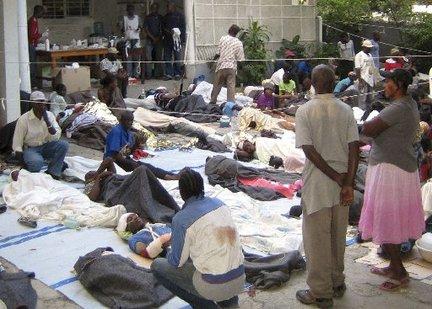Haiti’s never-ending tragedy has American roots

Late last week, the White House website carried details of a 30-minute phone conversation last Friday morning between President Barack Obama and René Préval, the president of Haiti.
It reported: ‘‘President Obama said that the world had been devastated by the loss and suffering in Haiti, and pledged the full support of the American people for the government and people of Haiti as it relates to both the immediate recovery effort and the long-term rebuilding effort.
(Picture: wounded people gathered at the office of Medecins Sans Frontieres in Port-au-Prince, Haiti)
‘‘President Préval said that he has been touched by the friendship of the American people, and expressed his condolences for the loss of American citizens in Haiti."
The report continued: ‘‘President Préval closed by passing a message to the American people - ‘From the bottom of my heart and on behalf of the Haitian people, thank you, thank you, thank you’."
It would be churlish to criticise the president of a country devastated by tragedy, when he was pleading with the world for support at a time of such crisis for his people. But he could have been forgiven for being less wholehearted, for the story of Haiti is maybe the most vivid representation of imperialist murderous oppression in world history. That oppression added hugely to the tragedy that the earthquake brought last Tuesday to the people of Haiti.
Right from the beginning of the reports on the earthquake last Tuesday night, Haiti was repeatedly referred to as the poorest country in the western hemisphere. Rarely was it explained why this was so.
The island on which Haiti and the Dominican Republic are situated was inhabited thousands of years ago by the Taino people, a branch of the Arawak, who populated the Caribbean and the eastern coast of South America down to Brazil. These were the people encountered by Christopher Columbus in 1492. He called the island Hispaniola.
The native population was quickly decimated and eventually extinguished when the civilising Europeans ‘‘discovered’’ it.
The Spaniards began importing African slaves into Hispaniola in the early 16th century.
In 1697, the Treaty of Ryswick divided the island between the Spanish and the French, with France receiving the western third, Haiti. It became the richest French colony in the New World, earning for its colonisers huge profits from sugar and coffee and the labour of the African slaves.
The French enacted the Code Noir, which sanctioned the most brutal treatment of slaves .A memoir from the time described how slaves were hung up with heads downward, drowned in sacks, crucified on planks, buried alive, thrown into boiling cauldrons, or consigned to man-eating dogs.
The French Revolution in 1789 prompted a revolution by the slaves in Haiti, and the French National Assembly abolished slavery. Following an unsuccessful intervention by Napoleon in the early 19th century, Haiti won independence and proclaimed itself a republic on January 1,1804.
In 1825,Charles X of France attempted to reconquer Haiti.
The then president, Jean-Pierre Boyer, agreed to pay the equivalent of €20 billion in today’s money as compensation for the profits lost by the French colonists by the abolition of slavery. Not surprisingly, many Haitians still demand that France repay this ransom.
A succession of coups followed into the 19th century. In 1888,US Marines supported a revolt against the government. The Germans did the same in 1892 and, in 1915, the US invaded and occupied the island until 1934.
The instigation for this occupation arose from a consortium of American investors, assembled by the National City Bank of New York, taking control of Banque Nationale d’Haiti, the country’s only commercial bank.
It and other US banks which had lent money to the Haitian government urged the then US president, Woodrow Wilson, to invade Haiti and take control.
A new constitution was imposed and approved in a plebiscite in which only 5 per cent of the people of Haiti voted.
Forced labour was imposed.
The Haitian economy was opened to American imports.
The law forbidding foreigners from taking control of Haitian companies was repealed. Another regime of gross human rights abuses followed. Franklin Roosevelt ended the occupation in 1934, but the US retained control of Haiti’s external finances until 1947.
A decade later, the Americans engineered the imposition of the Duvalier tyranny on Haiti, as a bulwark against the spread of communism from Cuba. This family dictatorship lasted until 1986.
In December 1990, JeanBertrand Aristide was elected president with 67 per cent of the vote. The Americans covertly supported a coup against him in 1991. In 1994,US President Bill Clinton engineered the return of Aristide on terms that forced him to adopt the neoliberal programme promulgated by the candidate he defeated in 1990, and which the country had rejected.
Aristide was disbarred from standing in the presidential election in 1996, but he won the presidency back in 2000. In 2004, the Americans again engineered his removal, this time arranging for him to be kidnapped and deported to the Central African Republic.
Meanwhile, Haiti was ravaged by corruption and the imposition of economic policies that drove people out of agriculture into the slums of cities where they died in their tens of thousands last Monday, unprotected by the ramshackle hovels in which they were forced to live.
Tens of thousands have gone illegally to the US over the past few decades, to escape the misery of Haitian life. Most formed families and had children; then, in 2008, a move was made to deport some 20,000 of them. The Bush administration deferred deportations following the hurricanes in Haiti that year but, almost as soon Barack Obama came to office a year ago, the deportations were ordered to commence.
The pity of this latest tragedy is that the president of Haiti says thank you, thank you, thank you, to America for all it has done.
